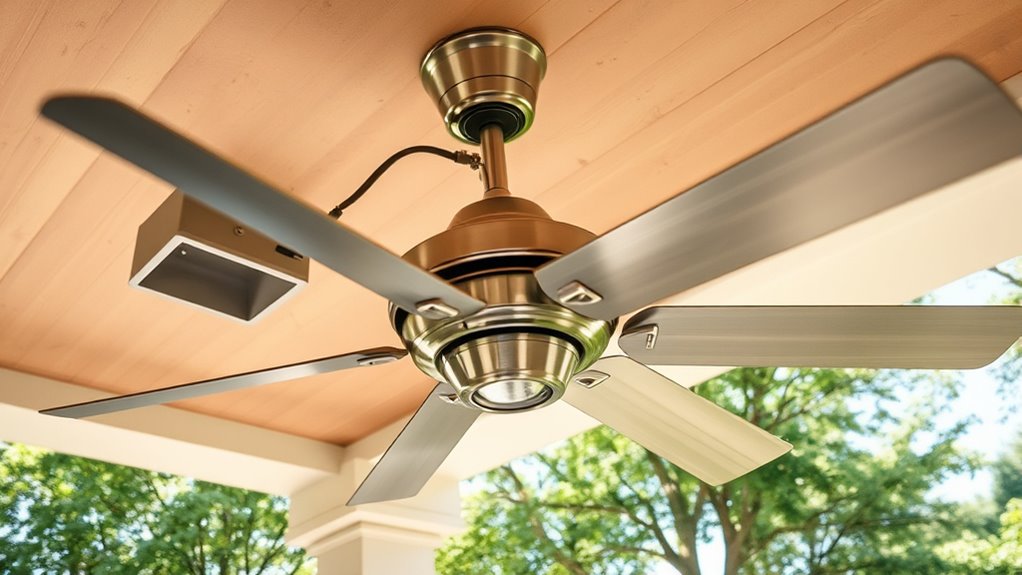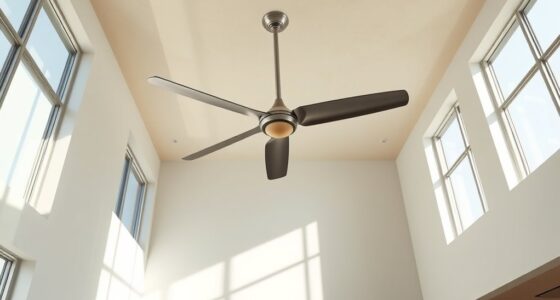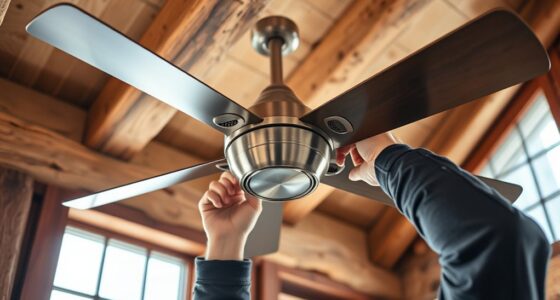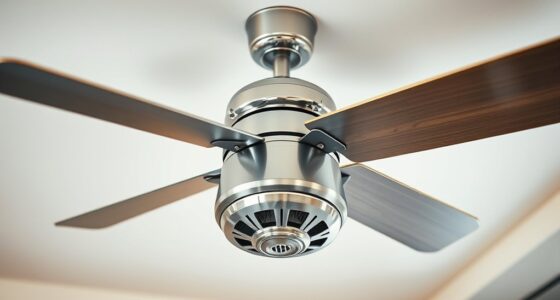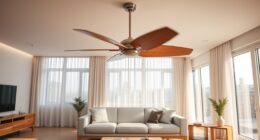When installing outdoor-rated fans, you must follow local electrical codes and manufacturer instructions to guarantee safety and durability. This includes using weatherproof wiring, enclosures, and sealing connections against moisture. Proper grounding and GFCI protection are essential to prevent shocks and hazards. Verify your circuit can handle the fan’s load and obtain necessary permits and inspections. Staying compliant helps avoid violations and guarantees a safe, effective installation—continue exploring to get detailed steps and tips.
Key Takeaways
- Use outdoor-rated fans with weatherproof housing, sealed motors, and corrosion-resistant materials for outdoor installations.
- Install fans at a minimum height of 7 feet above the ground for safety and optimal airflow.
- Ensure all wiring is outdoor-rated, properly grounded, and protected in weatherproof enclosures per local electrical codes.
- Obtain necessary permits, submit installation plans, and have inspections to verify code compliance and safety standards.
- Regularly inspect and maintain fans to prevent hazards, ensuring secure wiring, proper mounting, and absence of damage.
Understanding the Relevant Electrical Codes and Standards
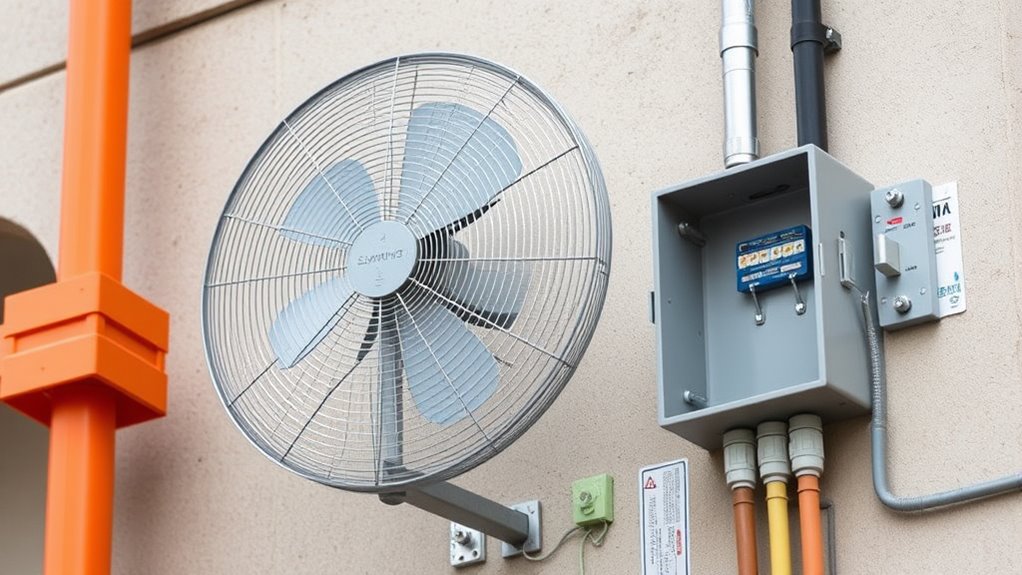
Understanding the relevant electrical codes and standards is vital before installing outdoor-rated fans, as these rules guarantee safety and proper functionality. By adhering to these standards, you guarantee maximum ventilation efficiency, helping your outdoor space stay comfortable and well-ventilated. Proper compliance also supports aesthetic integration, allowing your fan to blend seamlessly with your environment without compromising safety. Local codes specify grounding, wiring, and weatherproofing requirements that prevent electrical hazards. Failing to follow these standards can lead to equipment failure or safety risks, which could damage your outdoor setup’s appearance and performance. Taking the time to understand and implement these codes ensures your installation is both safe and visually appealing, providing peace of mind and a more enjoyable outdoor experience. Additionally, considering outdoor-rated fan benefits can help optimize your outdoor space’s comfort and safety. Ensuring weatherproofing standards are met is also crucial for protecting the fan against the elements and extending its lifespan. Properly following electrical safety standards minimizes the risk of electrical shock and fire hazards, further safeguarding your property and loved ones.
Selecting the Appropriate Outdoor-Rated Fans

When choosing outdoor-rated fans, you need to consider weather resistance features to ensure they withstand the elements. Make sure the fans meet relevant certifications and standards for outdoor use to guarantee safety and durability. Additionally, selecting the proper size to match your space is crucial; a correct sizing ensures effective airflow without over- or under-sizing the fan. Incorporating automation technologies can also help in making informed decisions when installing outdoor fans.
Weather Resistance Features
Choosing the right outdoor-rated fan requires paying close attention to its weather resistance features, especially if you want it to withstand the elements year-round. Look for fans with corrosion-resistant materials like stainless steel or coated aluminum to handle moisture and humidity. A weatherproof housing is essential to protect internal components from rain, dust, and debris. Consider models with sealed motors and electrical connections to prevent water intrusion. Proper weather resistance ensures your fan remains functional and safe, just like lighting fixtures designed for outdoor use. Additionally, good airflow can improve indoor ventilation when needed, but outdoor fans must be specifically built to endure outdoor conditions. Prioritizing weather resistance features guarantees longevity and reliable performance in any climate. Ensuring the fan’s components are protected from water intrusion is critical for maintaining safety and durability over time. Incorporating weatherproofing techniques during installation can further enhance the fan’s resilience against harsh environmental factors.
Certification and Standards
Selecting the right outdoor-rated fan means paying attention to certifications and industry standards that verify its durability and safety. Look for models with UL or ETL listings, ensuring they meet rigorous safety requirements. Certifications also confirm the fan’s weather resistance, making it suitable for outdoor conditions. When choosing a fan, consider outdoor aesthetics—selecting a design that complements your space and enhances its visual appeal. Additionally, check fan noise levels to ensure comfort, especially in seating or dining areas. A certified outdoor fan should operate quietly without disrupting conversations or relaxation. By prioritizing these standards, you make certain your fan not only performs well but also lasts longer and maintains safety, giving you peace of mind during outdoor gatherings or everyday use. Incorporating AI-driven solutions can also assist in selecting the best models based on performance data and environmental factors. Proper installation following building codes further ensures safety and longevity.
Proper Size Selection
Getting the size right is essential to guarantee your outdoor fan provides adequate airflow without overwhelming your space. Choose a fan with the correct blade size to match your area; too small, and it won’t circulate enough air, too large, and it may create discomfort. Proper fan blade selection ensures ideal airflow direction, whether you want to push air down or circulate it around. Consider the fan’s airflow capacity, measured in CFM (cubic feet per minute), to match your needs. Additionally, selecting the right fan size helps prevent potential side effects like noise or insufficient cooling. Ensuring proper outdoor-rated fan installation is crucial for safety and optimal performance. Optimizing your remote work environment with appropriately sized fans can also boost comfort and productivity during outdoor work sessions.
Proper Wiring and Grounding Practices for Outdoor Fans
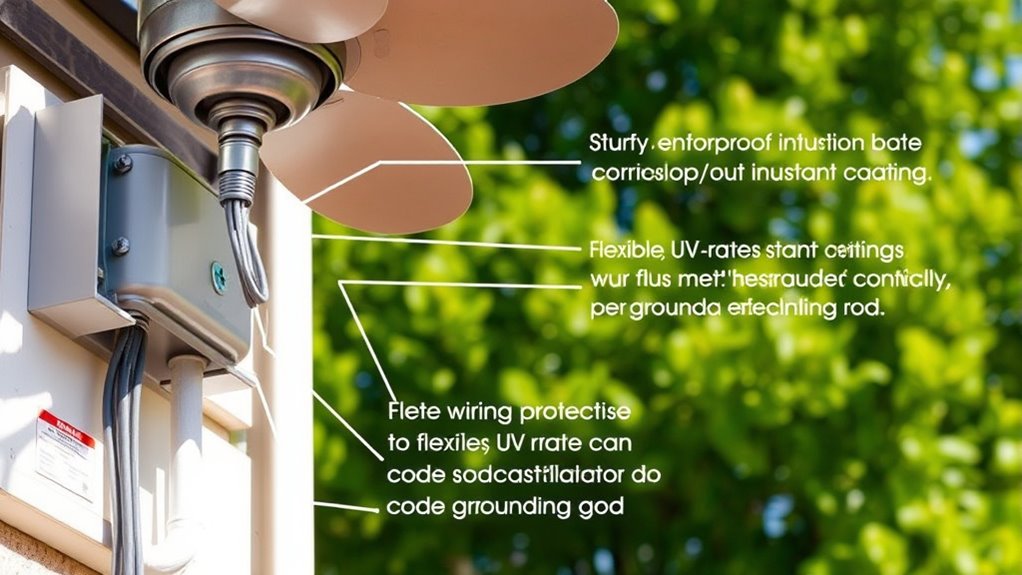
When wiring outdoor fans, you need to follow specific outdoor wiring standards to guarantee safety and reliability. Proper grounding connection is essential to prevent electrical hazards, and using weatherproof enclosures protects the connections from the elements. Paying attention to these practices helps keep your outdoor fan installation safe and long-lasting. Additionally, ensuring that wiring connections support adequate voltage and current ratings prevents overheating and electrical failures. Using appropriate circuit protection devices is also crucial to safeguard against electrical overloads.
Outdoor Wiring Standards
To guarantee your outdoor fan operates safely and reliably, proper wiring and grounding are essential. Outdoor wiring standards ensure protection against weather and electrical hazards. Use weatherproof connectors, conduit, and proper insulation to meet code requirements. When planning lighting design and aesthetic considerations, choose wiring methods that blend seamlessly with your outdoor decor while maintaining safety. Proper grounding prevents electrical shocks and damage. Remember to install GFCI outlets for added safety and follow local electrical codes. To help visualize key points, consider this table:
| Aspect | Requirements | Tips |
|---|---|---|
| Wiring Material | Weatherproof, UV-resistant cables | Use outdoor-rated cables for durability |
| Connectors | Waterproof and corrosion-resistant | Seal all connections tightly |
| Grounding | Proper grounding methods | Always connect to grounding system |
| Lighting Design | Integrated with wiring | Choose fixtures that complement aesthetic considerations |
| Conduit Protection | Enclosed wiring runs | Protect wiring from physical damage |
Additionally, incorporating outdoor-rated wiring ensures longevity and safety in harsh weather conditions.
Grounding Connection Requirements
Proper grounding is essential for the safe and reliable operation of outdoor fans, as it helps prevent electrical shocks and protects your equipment from damage. Many grounding misconceptions exist, such as believing that grounding is optional or unnecessary for outdoor installations. In reality, grounding safety is critical and mandated by code to ensure any stray electrical current is safely directed into the earth. You must use a grounding wire connected to a proper grounding terminal or grounding rod, following the manufacturer’s instructions and local electrical codes. Always verify that your grounding connections are secure, corrosion-resistant, and compliant with standards. Ignoring proper grounding can lead to electrical hazards, equipment failure, or fire risks, so prioritize correct grounding practices for safe outdoor fan operation.
Weatherproof Enclosure Use
Using a weatherproof enclosure is essential for guaranteeing your outdoor fan’s wiring and grounding connections stay protected from the elements. It prevents moisture, dust, and debris from compromising electrical safety and longevity. When selecting the enclosure, consider these points:
- Choose a NEMA-rated enclosure suited for outdoor use to withstand weather conditions.
- Ensure proper sealing to prevent water ingress, especially if the fan is near pools or humid areas.
- Think about aesthetic considerations—opt for enclosures that blend with your outdoor decor, especially if installed in visible areas, or use simpler designs for indoor applications with outdoor exposure.
- Incorporate appropriate grounding techniques within the enclosure to ensure electrical safety and compliance with code requirements.
- Selecting an enclosure with ventilation options can also help prevent condensation buildup inside, maintaining the integrity of your wiring over time.
Proper weatherproof enclosures safeguard your wiring and grounding, ensuring safe, reliable operation while maintaining a clean appearance.
Ensuring Weatherproof Enclosures and Connections
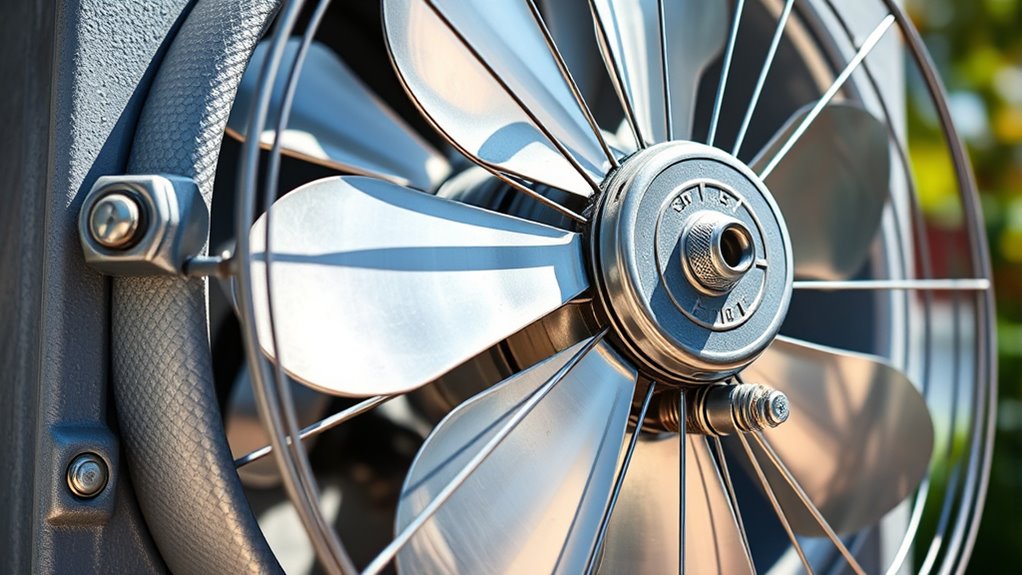
Ensuring weatherproof enclosures and connections is vital for the reliable operation of outdoor-rated fans. Proper sealing prevents moisture from entering, which protects indoor safety by reducing electrical hazards. When installing, make sure all connections are tightly sealed with weatherproof fittings and rated enclosures designed for outdoor use. This not only maintains safety but also preserves aesthetic considerations by avoiding unsightly exposed wiring or corrosion. Use weatherproof junction boxes and gaskets, and verify that all covers are securely fastened. Properly installed enclosures keep electrical components dry and protected from the elements, ensuring long-term performance. Remember, well-sealed connections are essential for safety, durability, and maintaining a clean, professional appearance in outdoor environments.
Ground-Fault Circuit Interrupters (GFCIs) and Their Role
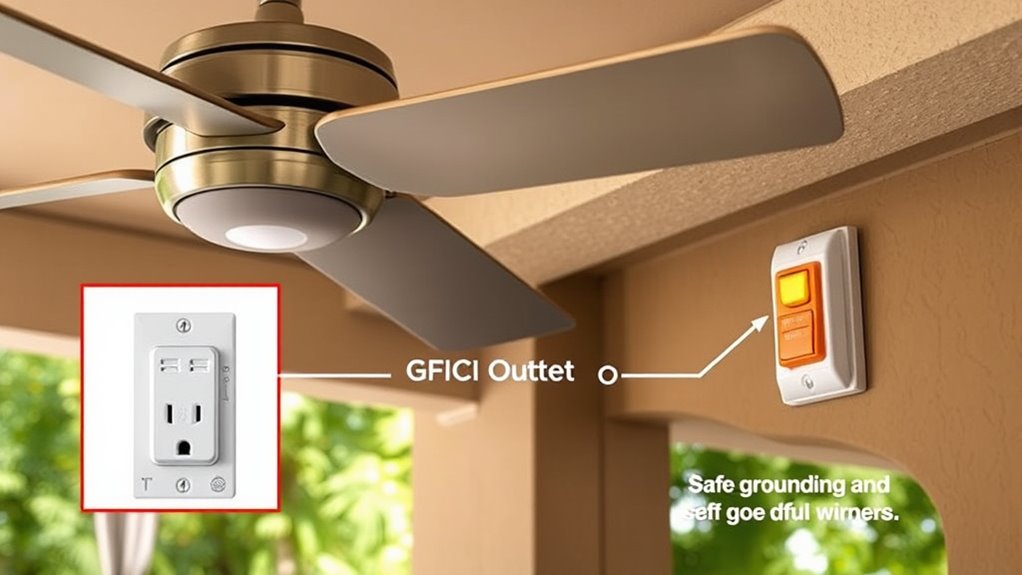
Ground-fault circuit interrupters (GFCIs) play a crucial role in outdoor fan installations by protecting you from electrical shocks caused by ground faults. They detect imbalances in current flow and shut off power quickly, ensuring safety. When installing outdoor fans, you’ll typically use GFCI receptacles to provide ground fault protection. Here’s what you should picture:
- A weatherproof GFCI outlet installed outdoors, ready to cut power if a ground fault occurs.
- The GFCI’s test and reset buttons, ensuring the device is functioning properly.
- The outdoor fan plugged into the GFCI receptacle, with safety features active and reliable.
- Adhering to these safety measures is essential, as code requirements mandate GFCI use in outdoor electrical installations. Additionally, understanding outdoor electrical safety best practices can help prevent accidents and ensure compliance with local codes.
Mounting Requirements for Outdoor Fans
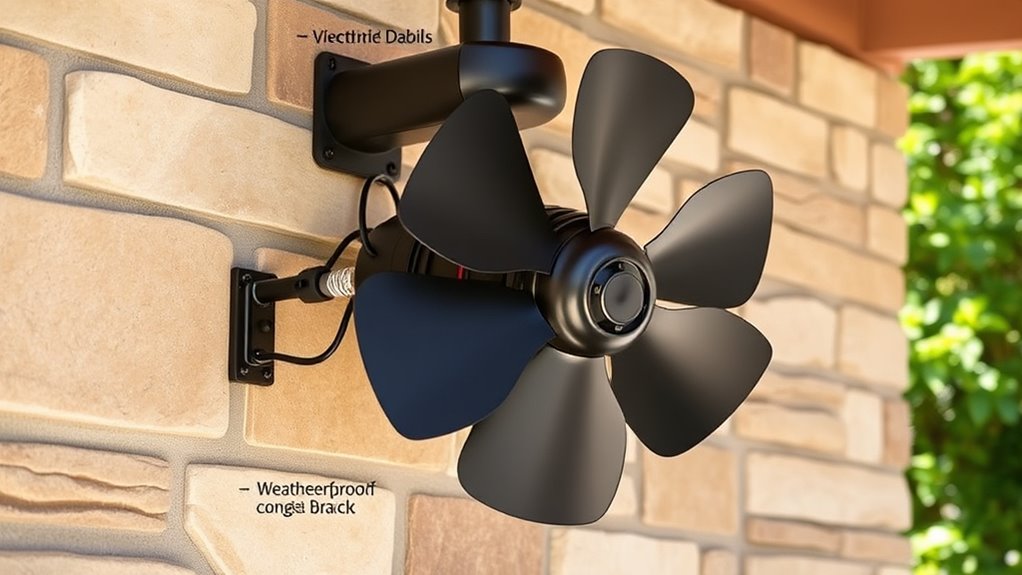
Proper mounting is essential for the safe and effective operation of outdoor fans. You should ensure the fan is securely attached to a stable, weather-resistant surface to prevent movement or tipping. The mounting location must support the fan’s weight and vibrations, which helps maintain motor efficiency and prolongs its lifespan. Avoid installing the fan where it can be exposed to excessive moisture or debris that could damage the fan blade or motor. Use approved mounting brackets or hardware that meet local electrical codes. Properly aligned mounting reduces strain on the fan blade and motor, enhancing performance and reducing noise. Always follow manufacturer instructions and code requirements to make certain your outdoor fan operates safely and efficiently over time. Additionally, ensure the installation site is compliant with local electrical codes to prevent potential hazards and ensure legal compliance. Ensuring your installation complies with safety standards can also help prevent structural issues and extend the longevity of your fan. Incorporating hydrocolloid technology in product design can further improve the durability of certain outdoor components.
Power Supply and Circuit Capacity Considerations
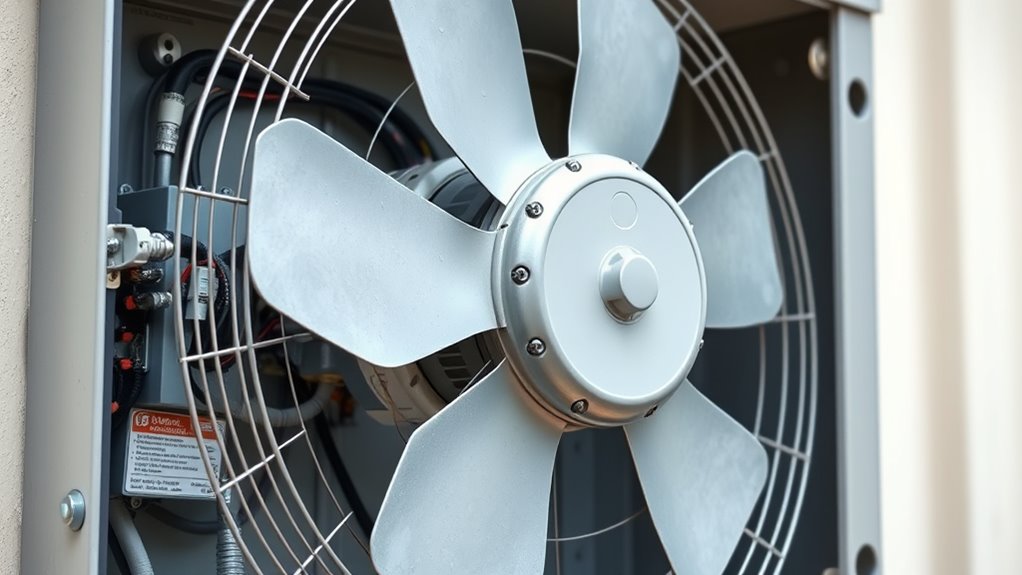
Before installing an outdoor fan, you need to verify that the electrical supply can handle its power requirements. Making certain of sufficient circuit capacity prevents overloads and electrical hazards. Consider these factors:
- Check the fan’s wattage and amperage ratings to match existing circuits.
- Use dedicated circuits for high-power fans to ensure airflow enhancement.
- Confirm that the wiring and breaker sizes comply with local electrical codes.
Choosing fan blade materials influences airflow efficiency and durability in outdoor conditions. Proper power supply guarantees the fan operates effectively without tripping breakers or causing voltage drops. Adequate circuit capacity supports ideal airflow, maximizing fan performance and longevity while maintaining safety standards. Always consult a qualified electrician to verify your system before installation.
Inspection and Permitting Processes
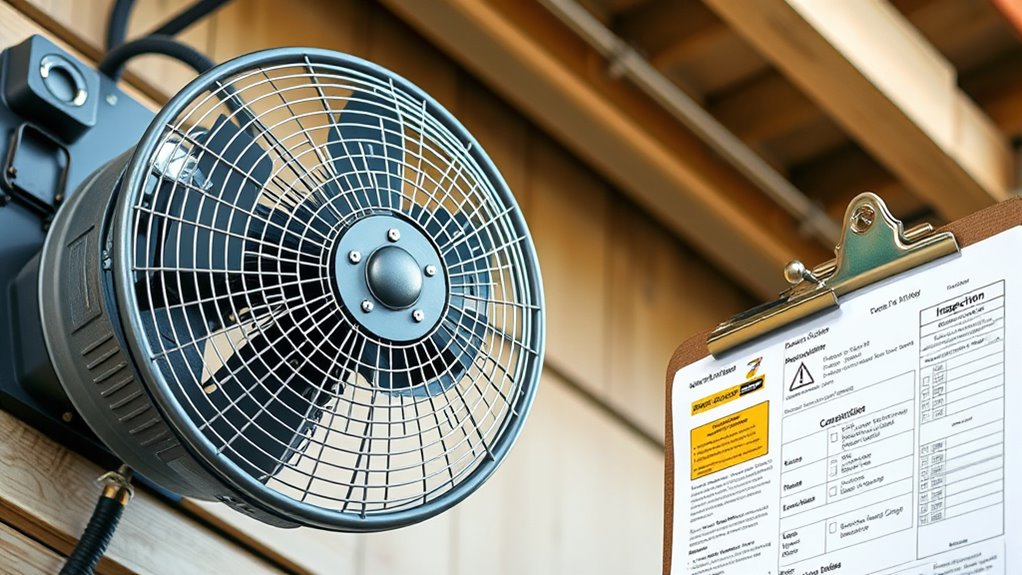
Ensuring your outdoor fan installation complies with local regulations requires obtaining the necessary inspections and permits. During the inspection, authorities will check that the fan blade is securely installed and meets safety standards. They’ll also verify that the motor efficiency complies with energy codes, ensuring your fan operates effectively without wasting power. Permits typically require submitting plans that detail the fan’s placement, electrical connections, and specifications. Inspectors will confirm that wiring is correct and that the fan’s outdoor-rated components are properly installed to withstand weather conditions. Skipping this process can lead to fines or needing costly modifications later. Be prepared to provide documentation of your fan’s specifications, including the motor efficiency rating, to facilitate a smooth approval process.
Common Violations and How to Avoid Them
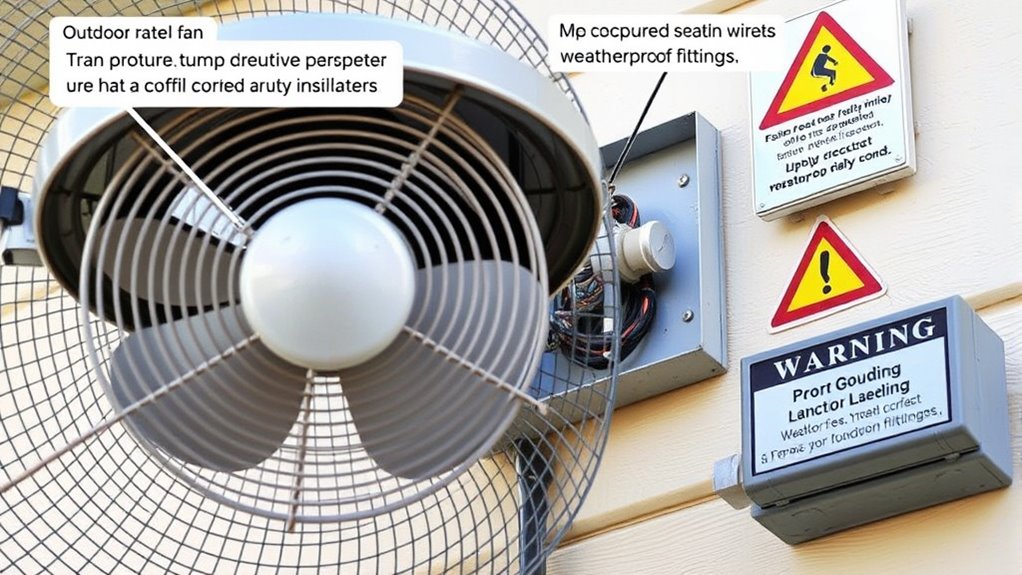
Many common violations occur during outdoor fan installations that can lead to safety hazards or code violations. First, installing fans with incorrect fan motor types, like non-weatherproof motors, can cause electrical issues or damage. Second, neglecting proper installation height—installing fans too low or too high—can compromise safety and airflow efficiency. Third, failing to follow manufacturer specifications and local code requirements often results in improper mounting or wiring. To avoid these violations, verify you select outdoor-rated fans with weatherproof motors designed for exterior use. Confirm the installation height adheres to code, typically at least 7 feet above the floor or ground. Always confirm your setup matches manufacturer instructions and local electrical codes to maintain safety and compliance.
Maintenance and Safety Checks Post-Installation
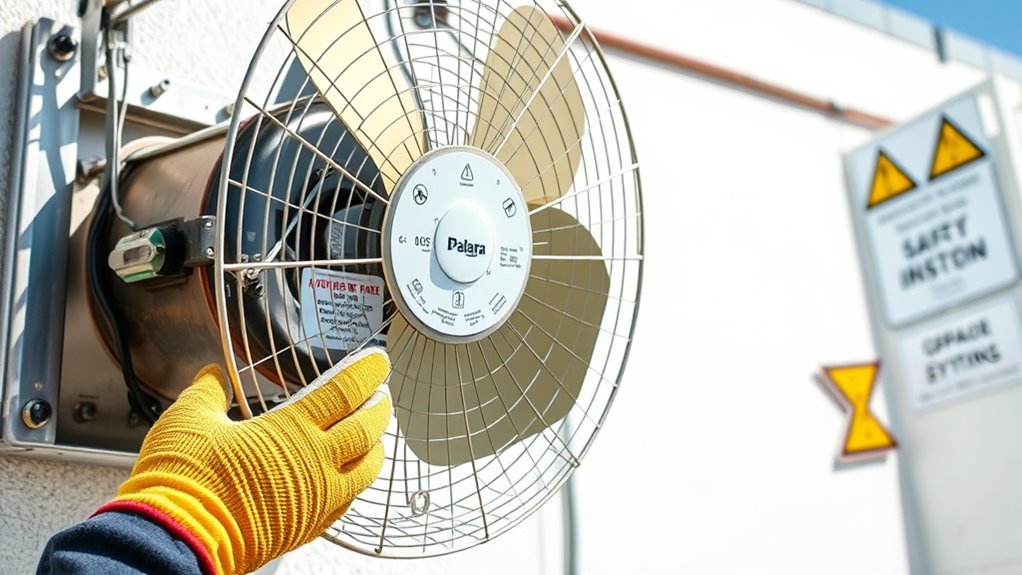
After installing your outdoor-rated fan, it’s crucial to perform regular inspections to guarantee everything remains in safe working order. Check for loose connections, corrosion, or damage that could pose hazards. Staying proactive helps prevent safety issues and keeps your fan operating smoothly.
Regular Inspection Procedures
Regular inspection procedures are essential to maintain the safety and ideal performance of outdoor-rated fans. Regular checks ensure the ventilation efficiency remains perfect and the aesthetic design stays intact. To keep your fan in top shape, consider these steps:
- Examine the blades and housing for debris, corrosion, or damage that could impair airflow.
- Inspect electrical connections for signs of wear or corrosion, ensuring safety and reliable operation.
- Verify that the fan’s mounting and surroundings are secure, with no obstructions affecting airflow or aesthetics.
These routine inspections help prevent issues that could compromise safety or reduce ventilation efficiency. Keeping the fan clean and well-maintained also preserves its aesthetic appeal, ensuring it functions smoothly and looks attractive in your outdoor space.
Safety Hazard Prevention
To guarantee your outdoor-rated fan remains safe and reliable, you should perform maintenance and safety checks immediately after installation. These checks help prevent hazards that could compromise the indoor climate or cause electrical issues. Start by inspecting all connections, ensuring they’re secure and free of corrosion. Check for any exposed wiring or damage to the fan housing that could pose electrical shock risks. Verify that the fan is properly grounded as per code requirements. Test the fan’s operation to confirm it runs smoothly without unusual noise or vibrations. Regular maintenance like cleaning blades and vents prevents debris buildup, which can impact safety and efficiency. Performing these safety checks safeguards your environment, supports ideal indoor climate control, and prolongs the fan’s lifespan.
Frequently Asked Questions
Are There Specific Outdoor Fan Models Approved by Local Building Codes?
You should look for outdoor fan models with proper fan certifications and outdoor fan ratings, as these guarantee the product meets safety standards. Local building codes often specify approved outdoor fans, so check if the models you’re considering are listed or certified for outdoor use. By choosing fans that meet these outdoor-specific ratings, you guarantee safe, compliant installation and reliable performance in outdoor environments.
How Often Should Outdoor Fans Be Inspected for Safety Compliance?
Imagine your outdoor fan quietly humming, keeping the air fresh and safe. You should inspect it at least once a year for electrical safety and overall condition. Regular maintenance schedules help catch issues early, preventing hazards. Look for corrosion, loose wiring, or damaged blades. Staying vigilant guarantees your fan remains a safe, reliable part of your outdoor space, protecting you and your loved ones from potential risks.
Can Outdoor Fans Be Installed in Wet or Humid Environments?
You can install outdoor fans in wet or humid environments if they have proper corrosion resistance and moisture protection. Look for fans rated for outdoor use, featuring weatherproof seals and corrosion-resistant materials. These features guarantee the fan withstands moisture exposure without rusting or malfunctioning. Always follow manufacturer instructions and local codes to ensure safe, reliable operation in challenging conditions. Properly rated fans extend durability and maintain safety in moist environments.
What Are the Consequences of Non-Compliance With Outdoor Fan Installation Codes?
Missing outdoor fan installation codes is like sailing without a compass—you risk electrical safety hazards and costly repairs. If you ignore permitting requirements, inspectors may shut down your project or demand costly corrections. Non-compliance can lead to electrical shocks, short circuits, and even fires. Stay on the right path by following code guidelines; it keeps your installation safe, legal, and protected from future troubles.
Are There Special Considerations for Outdoor Fan Installation on Decks or Patios?
When installing outdoor fans on decks or patios, you need to consider weatherproof wiring to prevent damage from moisture and corrosion resistance to ensure longevity. You should select fixtures rated for outdoor use and properly seal all connections. Additionally, verify that the installation complies with local electrical codes, ensuring safety and durability. Properly addressing these considerations helps your fan withstand the elements and function reliably over time.
Conclusion
By following these code requirements, you’ll guarantee your outdoor fan installation stands the test of time and weather. Don’t cut corners or ignore safety standards—you don’t want to open a can of worms later. Think of it as building a house on a solid foundation; doing it right now saves headaches down the road. Stay diligent, keep safety in mind, and enjoy a breeze that’s both cool and compliant.
